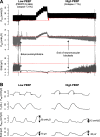High PEEP may have reduced injurious transpulmonary pressure swings in the ROSE trial
- PMID: 31829216
- PMCID: PMC6907242
- DOI: 10.1186/s13054-019-2689-x
High PEEP may have reduced injurious transpulmonary pressure swings in the ROSE trial
Conflict of interest statement
The authors declare that they have no competing interests.
Figures

Comment on
-
High Positive End-Expiratory Pressure Renders Spontaneous Effort Noninjurious.Am J Respir Crit Care Med. 2018 May 15;197(10):1285-1296. doi: 10.1164/rccm.201706-1244OC. Am J Respir Crit Care Med. 2018. PMID: 29323536 Free PMC article.
References
-
- Morais CCA, Koyama Y, Yoshida T, Plens GM, Gomes S, Lima CAS, Ramos OPS, Pereira SM, Kawaguchi N, Yamamoto H, et al. High positive end-expiratory pressure renders spontaneous effort noninjurious. Am J Respir Crit Care Med. 2018;197(10):1285–1296. doi: 10.1164/rccm.201706-1244OC. - DOI - PMC - PubMed
-
- Lindqvist J, van den Berg M, van der Pijl R, Hooijman PE, Beishuizen A, Elshof J, de Waard M, Girbes A, Spoelstra-de Man A, Shi ZH, et al. Positive end-expiratory pressure ventilation induces longitudinal atrophy in diaphragm fibers. Am J Respir Crit Care Med. 2018;198(4):472–485. doi: 10.1164/rccm.201709-1917OC. - DOI - PMC - PubMed
Publication types
MeSH terms
LinkOut - more resources
Full Text Sources

